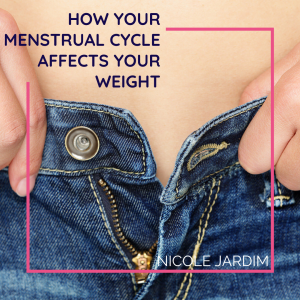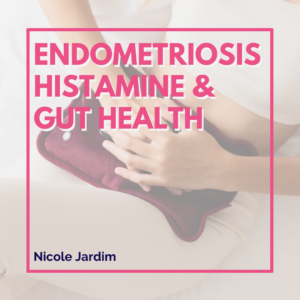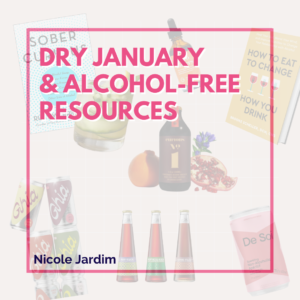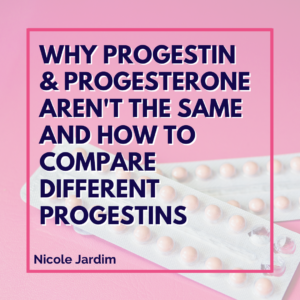Key Points to Remember from this post
I realize my posts are long, so I want to give you a few key takeaways. If you remember nothing else, just remember these gems. 🙂
- 99% of ALL the research papers ever published don’t fully account for the differences between women and men! There’s an obvious problem with this….women are not men!
- It is crucial that we eat and exercise according to our cyclical female rhythms. There’s even research and a diet called Menstralean to back it up! Keep reading for more info on it.
- Insulin sensitivity is higher in the follicular phase. This means that our blood sugar is more stable during this phase, because it is believed that estrogen enhances the efficiency of insulin.
- This is the time in your cycle when you can eat more carbs, or have sugar and alcohol because your body is better able to tolerate them.
- Progesterone can actually impair insulin sensitivity. [6, 7] This means that our bodies are more prone to blood sugar and insulin imbalances in the second half of our cycle. Symptoms include cravings, weight gain, bloating, mood swings, brain fog and bouts of fatigue.
- Eat less carbs, and higher protein and fat during the luteal phase to stabilize blood sugar.
- Stress raises cortisol, which raises blood sugar and prompts the body to store extra nutrients so it can be energetically prepared to overcome a stressful situation. Aka – weight gain.
- Without addressing your chronic stress, no diet in the world is going to be able to help with this issue.
Women’s hormones are totally connected to weight loss
50% of the women who seek my help for hormonal imbalances and period problems express trouble losing weight.
Women often feel like it’s their fault they can’t lose weight. They are usually told that their bad genes are to blame, they should eat less, exercise more, have more willpower…blah blah blah.
However, it is essential for us to know first and foremost that the odds are stacked against us when it comes to the science of losing weight. This is not well known, but nearly all of the exercise and nutrition research ever done has been done on men. And mostly young, healthy, college-age men, because those are the people most likely to volunteer for scientific studies!
Here are some shocking stats on that:
- The U.S. National Institutes of Health only began requiring women be included in clinical trials in 1994. That’s bad enough.
- But it wasn’t until 2016 that all research studies were required to show precisely how women did, separately from men. Nope, there’s no gender bias in medicine.
That means 99% of ALL the research papers ever published don’t fully account for the differences between women and men!
There’s an obvious problem with this….women are not men!
Haha no kidding right? We’re not even close to being metabolically or hormonally similar. In fact, we are built completely differently.
We have different hormones because we make babies, we have a different hormone cycle that is based on a monthly rhythm, whereas a man’s is dictated by a daily rhythm, we definitely have a different mindset and approach to life, and a totally different metabolism – AND all of this is dictated by what happens during our monthly menstrual cycle.
So it is reallllly crucial that we eat and exercise according to our cyclical female rhythms. There’s even research and a diet called Menstralean to back it up! [1]
Estrogen, progesterone and testosterone – how the menstrual cycle affects your weight throughout the month
Our feminine bodies produce different hormones each week of our cycle, and because of this there are significant changes that happen on an almost weekly basis. It’s very cool!
THE FOLLICULAR PHASE – menstruation and non-menstruating
For the first part of the follicular phase we are menstruating, which means there is not much action happening from a hormonal level – all hormones including estrogen, progesterone and testosterone are low because they are not needed.
Then we move into the non-menstruation part of the follicular phase, when the ovaries begin to prepare and ripen an egg.
Evidence suggests that insulin sensitivity is higher in the follicular phase, and decreases in the luteal phase of the menstrual cycle.[2] This means that our blood sugar is more stable during this phase, because it is believed that estrogen enhances the efficiency of insulin. Higher estrogen in the first half of the cycle will help keep blood sugar and insulin stable. [3, 4]
This is the time of the month where increased carbs are okay, and it’s fine to have a special sweet treat or drink alcohol (in moderation ladies – once or twice in this phase is plenty) because your body is much more able to handle those things. But if you pay attention, you’ll notice you don’t really crave these foods too much in this phase anyway though.
Estrogen also regulates the hunger and satiety mechanisms in the brain which will suppress appetite, and thus will make you feel lighter and less weighed down during this phase.[5]
Testosterone is also high at this point and enhances the benefits of higher estrogen – it helps you make muscle and create a leaner body with a healthy muscle/fat ratio. This is part of the reason your husband or boyfriend just sits on the couch and loses weight, because men have more testosterone and muscle. Such an injustice!!
For food, in the Menstralean study there was more protein in women’s diets – 30% versus 15-20% in the control group. Remember that your body can utilize carbs better than in the luteal phase, so higher carbs, lower protein and fat would be a good choice. After all, it takes a lot of energy to ovulate so it’s important to make sure you’re eating enough carbohydrates.
At the beginning of this phase during your period, it’s recommended to do less strenuous exercise like yoga, walking, and pilates, or nothing at all if that feels good too. Then after your period as estrogen and testosterone ramp up, you can move into higher intensity exercise 2-3 days a week and weights 2 days a week.
THE LUTEAL PHASE
Then we move from the follicular phase to the luteal phase, or the second half of the menstrual cycle. After ovulation, estrogen and testosterone gradually decline and the follicle that released the egg will start to produce progesterone, causing this hormone to rise gradually.
Progesterone is a heat-inducing hormone that actually raises your basal body temperature for the remainder of the luteal phase, prepping your body for a fertilized egg to survive and thrive.
When it comes to our blood sugar and weight, unlike estrogen, progesterone can actually impair insulin sensitivity. [6, 7] This means that our bodies are more prone to blood sugar and insulin imbalances in the second half of our cycle, and the symptoms that accompany those issues. These include cravings, weight gain, bloating, mood swings, brain fog and bouts of fatigue. In addition, rising progesterone tends to trigger water retention (hello boating), and constipation, which can make you feel a little puffy. Make sure to reduce your salt intake during this phase!
Interestingly, blood sugar imbalances are linked to too much or too little progesterone, which is so annoying. But basically all it means is there is a goldilocks amount of progesterone that is probably going to be a little different for each woman, based on her individual circumstances.
In addition, when estrogen drops in the luteal phase, it drags serotonin down with it. Lower serotonin is linked to increased appetite. We eat more carbs and sugar because that will quickly boost our serotonin, however, as you now know, the feel goods will be short lived! This is the reason SSRI’s (selective serotonin reuptake inhibitors) are used to treat PMS and PMDD. I have a better solution!
Ultimately, because we have less estrogen and more progesterone in the second half of our cycle, we have to be careful with our sugar, caffeine and alcohol intake, and really become a stress mitigation ninja. Otherwise, we’ll have more fat storage, especially around our bellies. And we will likely end up with more severe PMS symptoms. I always say that emotional PMS symptoms like cravings, moodiness, and a short temper are the same symptoms as being “hangry” – just another way of saying rollercoaster blood sugar.
For food, the Menstralean Diet suggests higher protein and healthy fats (to reduce cravings), and lower carbs during this phase. A little dark chocolate won’t kill you tho! 🙂 For exercise you may want to continue what you were doing in the follicular phase, but slowly taper down as you get closer to your period.
The luteal phase of your cycle is the time to optimize sleep!!
In one study, as little as 4 days of sleeping less than 5 hours per night increased insulin resistance by 30% in healthy individuals. [8]
Multiple studies showed that sleeping less than 5 hours per night significantly increased body weight. For every hour less than 8 hours of sleep, the expected difference in weight compared to an adult who got 8 hours was about 3 pounds. [9]
This is huge because so many of us are chronically sleep deprived! And since we are prone to having blood sugar imbalances in the second half of our cycle, then this is a critical time to WORK that sleep schedule. No more burning the candle at both ends in the second half of our cycle, because it is contributing to weight gain!
Stress and weight gain plus it’s connection to our sex hormones and menstrual cycle.
I can’t really talk about all of this without discussing stress and its connection to sex hormones and weight loss.
So here’s the scenario – you’re eating less and exercising harder, and doing all the things you’ve been told to do and nothing seems to work. You are still putting on weight, especially around your belly.
What the heck is going on?
Well, you’re probably burned out… burnout triggers hormonal imbalances, and these hormonal imbalances directly impact your metabolism. Remember, everything is connected in our bodies, so when one thing is off, it’s likely going to create a downstream effect.
When I get a client who is struggling with this, the first thing I ask them about is the amount of stress in their lives, and more importantly what measures they have in place to mitigate it’s effects. We’re all chronically overstimulated, which means it’s soooo important to figure out how to midwife ourselves through our chronic stress.
Here’s how this works….
As our stress ramps up, our adrenals produce stress hormones like cortisol in ever increasing amounts. Our body’s stress response is designed in a way that we optimize energy sources to help us overcome a stressful event. It does this in three ways:
#1 – Our appetite and cravings increase. To supply the body with the nutrients it needs to run for your life!
#2 – Our body sends messages to our gut telling it to absorb more nutrients from our food – so that the body is energetically prepared to overcome a stressful situation.
#3 – It raises our blood sugar. In order to provide the body with accessible sources of energy during stressful times, cortisol instructs the liver to create and store sugar. The obvious end result of this is an increase in blood sugar and increased sugar stores in the liver. If this cycle persists it can lead to insulin dysregulation, insulin resistance and even diabetes.
All of which make it very difficult to lose weight.
As I said before, a symptom of weight gain due to stress is an increased amount of fat around the waistline and abdomen. The reason fat accumulates in this area is due to it having a large concentration of cortisol receptors. It’s not the place you want fat accumulation because excess belly fat is correlated with diabetes, heart disease and metabolic syndrome.
In addition, if you’re looking to build muscle, cortisol is not going to be your friend! In order to fuel the body through its stressful event, cortisol decreases protein stores in the body by inhibiting the production of protein and stimulating the breakdown of muscle protein. Over time, this can lead to a state of chronic muscle breakdown and reduced muscle mass.
In other words, without addressing chronic stress, no diet in the world is going to be able to help with this issue.
You can get your cortisol levels checked by taking this at home Cortisol Test to measure adrenal performance and stress. Use code Hormones20 to get 20% off the test.
But there’s a twist! Our adrenals also produce a hormone called DHEA
While cortisol provides our bodies with a boost to help meet whatever challenge we’re facing, DHEA boosts how our brain functions to help us learn from the stressful situation we are in, and become stronger so that we can better deal with similar situations in the future.
DHEA reduces the effects of cortisol and vice versa, so if cortisol levels are high, DHEA levels are correspondingly low.
DHEA is a foundational building block for the sex hormones. Without it, our bodies could not produce essential hormones like testosterone or estrogen. In addition, DHEA has been shown to improve heart disease, dementia, immune deficiency, cancer, and osteoporosis.[10] DHEA peaks around age 25 and declines as we get older, which is why I call it the “fountain of youth” hormone.
These counter-effects on cortisol make DHEA a helpful friend when it comes to weight loss. DHEA instructs fat cells to stop taking in the energy that cortisol has told them to store, which causes these cells to reduce in size, reversing the weight gain effect of cortisol that I just mentioned.[11] DHEA also improves insulin sensitivity, further enhancing its weight loss ability.[12]
When we’re stressed to the max and not doing anything to mitigate the effects of that stress, our DHEA drops and subsequently our sex hormones drop. This causes period and fertility problems, and weight gain.
The quickest way to shift your DHEA to Cortisol ratio?
The simple act of thinking about stress in a more positive way will encourage your body to react to a difficult situation with more focus and courage.
People who were shown a video describing stress as harmful had a far lower ratio of DHEA to Cortisol, leading to negative physiological effects when faced with the stressful situation.
When people were shown a video describing stress as a positive thing that enhances themselves and strengthens their minds, it was found that when placed in a stressful situation, the levels of DHEA in these people skyrocketed.
So how can you begin reframing a stressful situation as a challenge, rather than a threat? Studies have shown that when people reinterpret their fight or flight response in this way, they become far more resilient to the detrimental effects of the stress response.[13] When you start thinking about stress differently, your body will start responding differently. xoxo
References:
- https://www.ncbi.nlm.nih.gov/pubmed/27281304
- https://www.ncbi.nlm.nih.gov/pubmed/10071420
- https://www.ncbi.nlm.nih.gov/pubmed/20071559
- https://www.ncbi.nlm.nih.gov/pmc/articles/PMC2999972/
- https://www.news-medical.net/news/20111020/Estrogen-regulates-energy-expenditure-appetite-and-body-weight.aspx
- https://www.ncbi.nlm.nih.gov/pubmed/20071559
- https://www.ncbi.nlm.nih.gov/pmc/articles/PMC2999972/
- https://www.ncbi.nlm.nih.gov/pmc/articles/PMC4435718/
- https://www.ncbi.nlm.nih.gov/pmc/articles/PMC2398753/#B37
- http://www.sciencedirect.com/science/article/pii/S0167494396007613
- https://www.ncbi.nlm.nih.gov/pubmed/25436721
- https://www.ncbi.nlm.nih.gov/pmc/articles/PMC3156603/
- https://www.ncbi.nlm.nih.gov/pubmed/11972140




7 thoughts on “How your menstrual cycle affects your weight”
Very nice job done by you. This is nice information I liked it. Thanks
Hey, Nicole, I was wondering if you have heard of this weight loss program before? https://cutt.ly/rrqW10F. It looks like a free program to help people lose weight, I was just looking for some opinions before I made my decision. By the way I love the content you have been posting!
Hey Nicole,
There’s a lot of information here! I can relate to a lot of these points. During my cycle, I often feel bloated – and then I get those pesky food cravings! I’ve gained a few pounds and so now I’m looking up methods for weight loss. I’ve been recommended this product by a college. Any thoughts? At first I thought it was scammy but I’m reading some really great reviews.
http://bit.ly/2K9PsfE
Hey (
nicolejardim) Do You Have Any Information About This Weight Loss Program https://weightlossquora.blogspot.com/ ?
It Looks Like A Great Program To Help People Lose Weight I Was Just Looking For Some Opinions Before I Make My Decision.
By The Way, I Love Your Content Keep Doing This Good Work..
Hello, when I take phytoestrogens like flax or soy, I feel better, less PM’s, joint pain, etc. However, my weight then goes up. How can I balance the benefits without the weight gain. And I am eating well and moderately active.
I would love to see all this charted out in a graph. I’m trying to follow along but it’s impossible. I understand that you thoroughly understand the phases, but they don’t make any sense to me and I don’t know at what phase is actually bleeding. As a layman that is my starting point. I did a Google for some menstrual cycle charts, but they don’t tell you when your energy is higher, when your appetite or cravings are, when is the best time to exercise. That is my current quest. I’ve noticed certain days of the month I have more energy than others, and more motivation than others. I need to sit down and find a good menstrual graph, and chart it out
If Day 1 = First day of menses, then…
Days 1-14 are Follicular Phase (able to eat more sugar/alcohol; less strenuous exercise)
Days 16-28 are Luteal Phase (eat less carbs, more protein, limit salt; high intensity exercise)